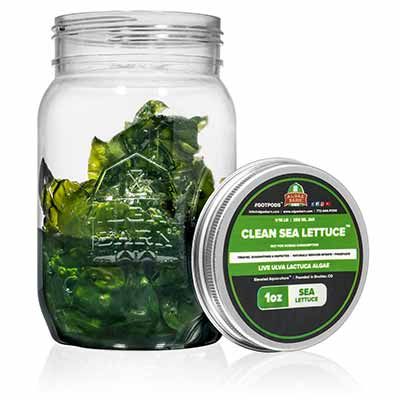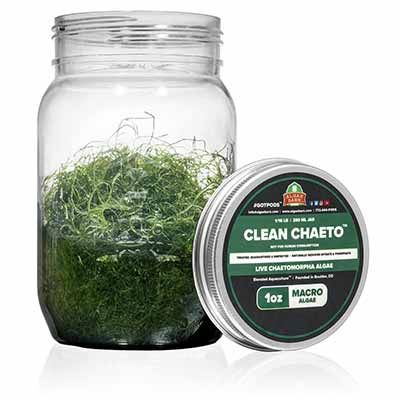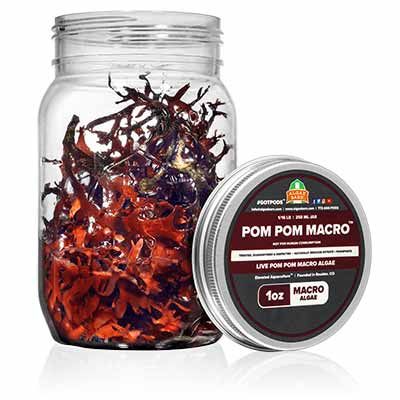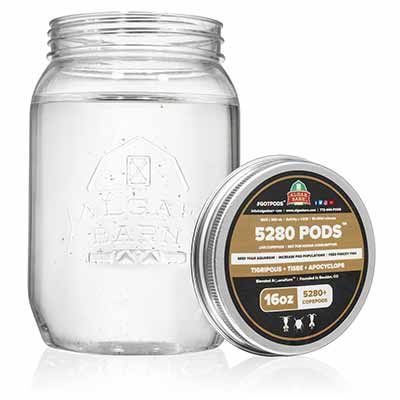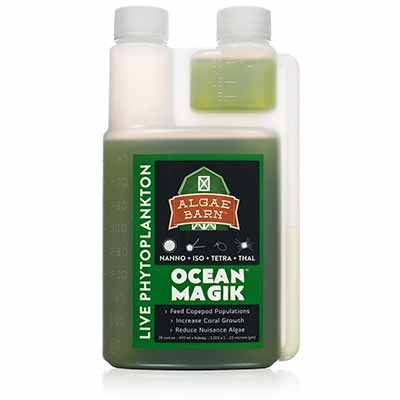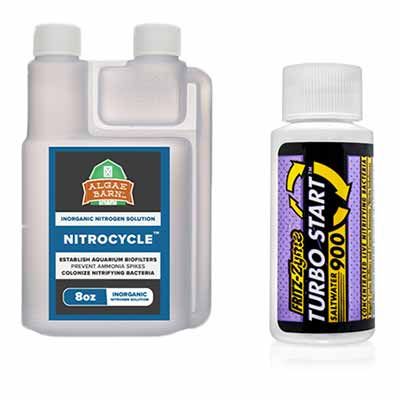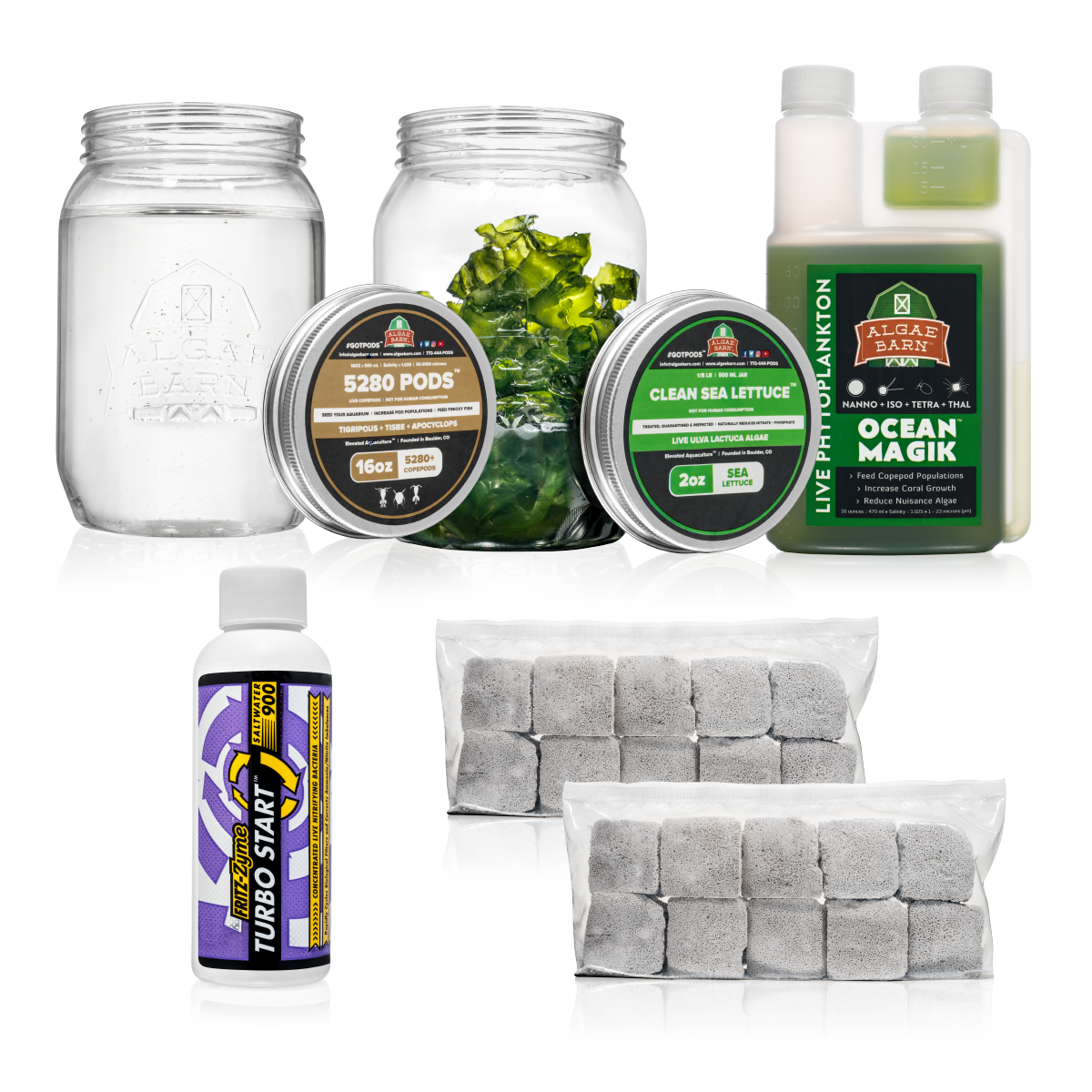A saltwater refugium is a separate area where macroalgae and microfauna can grow. Keeping a refugium helps macroalgae grow without fish eating it and without overrunning your main reef tank, and it provides a place for copepods and other isopods to multiply in peace.
Refugiums provide many benefits, including natural water filtration through macroalgae, stabilization of water conditions (especially pH and oxygen levels), serves as temporary acclimation tanks and provides a natural food source of zooplankton and phytoplankton.
What To Put In A Refugium
Best items to put in a refugium:
- Macroalgae such as sea lettuce or chaeto
- Live rock rubble or manufactured biological media
- Microfauna such as copepods and amphipods
- A powerful refugium light with a means of automatically controlling its on/off cycle
Optional items:
- Substrates such as sand or refugium mud
- Invertebrates or fish
Refugium algae
When it comes to macroalgae, the recommended types are Chaeto and Clean Sea Lettuce. They are the standard algae for a reason; they are easy to care for, they grow fast and they are efficient.
This is not like the algae that grow on your rocks or glass, that’s microalgae. Macroalgae that you grow in a refugium is not annoying or harmful. It is beneficial because it naturally filters the water and it’s the main advantage of having a refugium.
Best macroalgae for a refugium
The easiest to keep macroalgae is sea lettuce although chaeto is a popular and excellent alternative. There are other good macroalgae to choose from as well. Most notably, gracilaria is a good choice that comes in many varieties.
Sea lettuce
It improves the water quality and competes with nuisance algae by absorbing excess nutrients, it provides a biogenic substrate where various organisms (including copepods) can rest, hide and reproduce, and it proves a nutritious food source for various herbivorous invertebrates and fish.
Your refugium can produce enough sea lettuce to feed all of your herbivores while also helping keep your aquarium cleaner.
Chaeto
Chaetomorpha, often referred to as Chaeto for short and sometimes referred to as Spaghetti algae, is another popular macroalgae used in refugiums to reduce the phosphate and nitrate levels for more clean water in reef tanks. It is a non-invasive macroalga and can be easily trimmed when it grows in excess.
Pom Pom Gracilaria
Pom Pom Gracilaria is another macroalgae that grows well in a refugium and is excellent for nutrient export. Like sea lettuce, it can be fed to herbivores and is an excellent food source for them.
Pom Pom is a deeper red color unlike most other macroalgae. Its appearance is what draws most to it over the more effective sea lettuce or chaeto.
Live Rock Or Biological Media
Live rock is a great substrate for your refugium. They give additional space for helpful bacteria to grow and serve as a main nutrient exporter in the reef tank. Live rock can also provide shelter for microfaunae such as amphipods and copepods. Microfauna is a good food source for fish and corals and are excellent members of a cleanup crew. The porous rocks will provide a good home for the microfauna population, in addition to beneficial bacteria.
Microfauna
Microfauna is one of the great benefits of the refugium. All sorts of microscopic and macroscopic organisms thrive in a refugium and have great benefits for your saltwater reef system as a whole.
Copepods and Amphipods
Pods of all types are a great addition to any refugium and reef or saltwater aquarium. In the refugium, pods will consume all sorts of detritus that cycles through the plumbing from the display and settles in the refugium.
In addition to being a useful member of your cleanup crew, pods provide an excellent food source for coral and fish. If you plan to keep a mandarin goby, live pods are their primary food source, and caring for them without an extremely large refugium with a healthy pod population can be quite difficult.
Phytoplankton
Phytoplankton can potentially grow in your refugium but you’ll likely need to be dosing phytoplankton directly into your fuge to feed and maintain a healthy pod population. Phytoplankton will also make their way to your display tank and are a healthy food source for corals and other life in your main aquarium.
Beneficial Bacteria
Beneficial bacteria will grow in live rock or biological media in your fuge. The more beneficial bacteria the better. While a lot of bacteria will live in the live rock in your display tank, supplementing it by providing bacteria more porous rock, be it real or synthetic, is a great way of helping you maintain a healthy ecosystem that can be much more self-sustaining.
Refugium Light
LEDs are a common light source for refugiums. LEDs are popular due to their small size and incredible power. Other options such as fluorescents tend to be quite large and difficult to target the refugium well and metal halides produce far too much heat to be practical. Also, LEDs last an extremely long time and eliminate the need to replace bulbs.
I highly recommend Kessil LED lights for any aquarium lighting needs and they have a few excellent choices for refugiums. Personally, I use the Kessil A360X above my refugium on my 125-gallon tank. It’s not inexpensive but it’s extremely powerful and produces extremely healthy sea lettuce and keeps my display free of algae with the exception of some thin film algae that occasionally needs to be cleaned from the glass. The H160 Tuna Flora and H80 Tuna Flora are excellent alternatives for smaller aquariums. If you’re growing chaeto you may need to turn the intensity down a bit if you find the chaeto isn’t flourishing.
Other manufacturers make some great grow lights but Kessil is the best choice in my opinion. Going with a cheap grow bulb however probably won’t get you the results you’ll expect. It may work for smaller setups but a powerful grow light is the most effective choice.
Does a refugium need light?
Like all plants, macroalgae require light to grow and survive. The actual growth rate will be influenced by the intensity of the light they receive, as photosynthesis is the only way they eat, compared with corals.How long do you run your refugium light?
Establishing a photoperiod depends on how your refugium is set up. If you have a refugium that is attached to your display tank, you’d have to run the same lighting schedules. But if your refugium is separate, the recommended photoperiod is the opposite of your display tank. When your lights are on in your display tank they should be off in your refugium and vice versa. This will help you stabilize the pH and oxygen levels in the water. When photosynthesis happens, plants take up carbon dioxide from the water to store energy. This will alter the carbonic acid balance and raises pH. In a reef tank filled with photosynthetic corals, there is a lot of photosynthetic activity when lights are on, and therefore sharp pH swings can happen between day and night cycles. If you add the same imbalance of pH from your refugium by running the same light cycles, pH will swing even more dramatically. By alternating photosynthetic periods in your reef tank and refugium, you will create a balance within the system. Some reefers run their refugiums lights 24/7, however, that is not recommended because of the reason we discussed and because copepods need the cover of darkness to come out and feed.Optional - Substrate
I personally run my refugium bare bottom but there are arguments for including sand or refugium mud. Here are my thoughts on those choices. Your experience may be different and certainly, there are many paths to successfully maintaining a healthy reef aquarium.
Sand
Deep sand beds are touted for their ability to harbor beneficial bacteria. This is certainly true but I believe live rock or biological media to be a better option for this than sand. In my experience, sand can harbor a lot of detritus that needs to be removed and makes it more difficult for pods to consume. Stirring up the sand can also release a cloud that can be harmful to your aquarium livestock.
Refugium Mud
Miracle Mud is a product that is 80% sand. The product claims to have the ability to replenish trace elements inside the reef tank while also containing healthy bacteria for denitrification. There are plenty of examples where reef tanks thrive with this type of substrate in the refugium.
However, the benefits of the mud are debatable and nothing has been proved yet. It can also be hard to clean and it will have a lot of built-up waste over time, therefore it needs to be replaced a few times a year.
Optional - Invertebrates / Fish
Invertebrates
I have no invertebrates or fish in my refugium although some snails that like green film algae may be helpful in keeping your refugium cleaner and reduce competing algae. Trochus and ceriths are the best choices for this task.
Detritus-eating crabs and snails might be a good addition for heavily stocked or heavily fed tanks. Ideally, pods will do the heavy lifting of consuming detritus in your fuge but if they aren’t capable of keeping up with the influx you may want to add some additional help to keep up with the chore.
Fish
There aren’t really any fish that are recommended for keeping in a refugium although you certainly can do so. You may have reasons that you want to do this but there aren’t compelling reasons to do so for the health of your refugium or display.
The only time I’ve put fish in my refugium is to protect one that is getting picked on my other fish. Alternatively, you can put the fish that is doing the bullying in your refugium to allow the fish being bullied the opportunity to try to establish itself in the display before reintroducing the bully back into the main display. The idea here is that the bully may take the more passive role since it is the newcomer to the territory. It may take quite a while of keeping your fish separated for this to work and there’s a good chance it won’t but could be worth trying for some.
Types Of Refugium
There are basically 2 types of refugium – in-sump and hang-on.
Hang-On Refugium
These are refugiums that hang onto the rim of your display tank. Water is pumped from your display tank up an intake tube into the refugium reservoir. As the water level rises inside the refugium, the water is poured back into the display aquarium.
These types of refugiums are easy to access for removing macroalgae if it grows too big, somewhat cost-friendly, and they can use the lights and pumps you already have. The downside is that they don’t look too pretty, and you can’t use different lighting periods on your refugium and main tank.
Also, hang-on refugiums tend to be quite small which makes them far less effective at providing all of the benefits a more appropriately sized refugium can provide.
In-Sump Refugium
This is one of the most popular ways of setting up a refugium, by using your sump. You already got water movement and filtration media in there, you have a chamber that you can use, everything is good.
Sure, the refugium will be harder to access when you need to remove the macroalgae, but it won’t be an eyesore for your display tank and you can run separate lighting schedules on it. And you don’t need to add any extra pumps to your system, as you already have one in your sump that will move water through the refugium.
Refugium starter kit
Some companies only offer refugium starter kits and I highly recommend this approach if you’re adding a new refugium to your aquarium.
I’m a big fan of Algae Barn. They provide excellent refugium starter kits and I highly recommend you check them out. Their kits include macroalgae, biological media, pods, phytoplankton, and a bacteria starter.
You’ll still need the refugium itself and a grow light, but otherwise, you’ll have everything you need to kick start a healthy refugium.
Frequently Asked Questions About Refugiums
Does a refugium reduce nitrates?
Yes. The macroalgae you grow will consume nitrates, ammonia, and phosphates from your water, and therefore naturally reduce nitrates levels.
Does a refugium need light?
Like all plants, macroalgae require light to grow and survive. The actual growth rate will be influenced by the intensity of the light they receive, as photosynthesis is the only way they eat, compared with corals.
Does a refugium need sand?
It doesn’t need sand. However many reefers prefer to use deep sand beds in their refugiums. They are between 4-5 inches or 6-8 inches deep.
Deep sand beds are a great place for small creatures to dig into and algae to take root on.
The cons of using a sand bed are the collection of detritus over time and the increase in nitrates it will generate from all the waste. Dead or decaying materials get trapped in the sand bed and as they decompose, they release nitrates.
To maintain a deep sand bed in a refugium you need to perform regular cleaning to remove excess detritus. Sand will require occasional cleaning and replacing, and that can be a daunting project that requires removing everything from the refugium.
How does a refugium work?
A refugium works by creating an area in your system that is separated from your aquarium. In this area you can grow species that can’t live in your main tank because they are eaten or because they are visually unpleasant for your display tank; species that are beneficial in terms of water filtration or that are a good food source.
How big does a refugium need to be?
There is not a standard size as you can make it as big as you want, but the general recommendation is to have a refugium that is 10-50% the size of your display tank. The bigger you make the refugium the more advantages it will bring in terms of filtration and stabilization.
How much does a refugium cost?
The hang-on refugium is one of the cheapest types you can get, costing between $75 to $150 to set it up, while a sump-based refugium can cost between $350 to $600. The hang-on refugium brings a lot of disadvantages and that’s why many reefers prefer to have it in the sump.
Should I put snails in my refugium?
You should limit the number of snails and other plant-eating organisms from your refugium if you are using your refugium to filter water since you don’t want them to munch on your macroalgae.
Do you feed copepods in a refugium?
Some phytoplankton is naturally produced in your tank, but it is rapidly consumed by corals and other organisms. Therefore you need to feed the young pods if you want to support a high population. Regularly dose live phytoplankton in your refugium to support the growth of copepods.
Is a refugium worth it?
Having a refugium is definitely worth it and any reefer can confirm that. The water filtration provided by the macroalgae is great and you will have a big supply of healthy adult copepods that will become food for corals and fish.
A refugium is definitely worth it. A well set up, stocked, and maintained refugium will provide a natural means of nutrient export by removing nitrates and phosphates from your reef aquarium. It will also provide a natural live food source for many different fish, invertebrates, and corals in your display tank. A good refugium will help your aquarium move closer toward becoming a self-sustaining system that creates a healthier tank environment and requires less maintenance and equipment.
Can I put fish in my refugium?
Yes, you can put fish in a refugium but under typical circumstances, it isn’t ideal. Many fish will need room to swim and most refugiums become packed with macroalgae making it difficult for the fish to move around freely. Some small herbivores may thrive in a refugium, however.
You might want to avoid putting a fish that thrives on eating copepods and amphipods in your refugium. A voracious pod eater could significantly damage your pod population since the copepods and amphipods won’t have a safe haven.
Also, a refugium can serve well as a place to isolate a fish that is being picked on by other fish. It obviously won’t work as a quarantine tank since the water is shared, but it can provide a safe place for sickly fish to live without being abused until you can determine a course of action.
Do you clean a refugium?
Cleaning the refugium is not recommended as you will also suck up the pods from it. Just prune the macroalgae when it becomes too crowded and that should be enough. If you have microalgae overgrowing, make sure that your macroalgae have everything it needs to grow. If your macroalgae is given a healthy environment it will overgrow the microalgae.
Do saltwater tanks need a refugium?
Saltwater tanks don’t need a refugium to be successful. However, considering how many advantages a refugium brings to your display tank, you should consider having one.
How much flow through refugium?
The flow rate inside your refugium is not very important. There’s no evidence that high flow is useful. 3-6 times your display tank volume per hour is more than enough.
